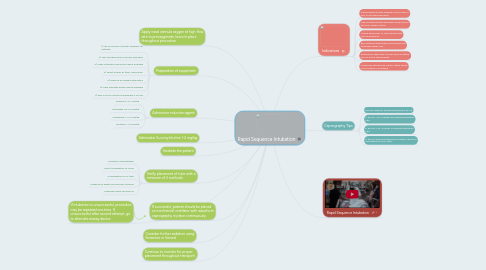Rapid Sequence Intubation
by Ashlynn Brees

1. Apply nasal cannula oxygen at high flow rate to preoxygenate, leave in place throughout procedure.
2. Preparation of equipment:
2.1. 1) Set up suction unit with Yankheur Tip Catheter
2.2. 2) Test laryngoscope for proper operation
2.3. 3) Video intubation should be used if available
2.4. 4) Select proper ET tube, check bulb.
2.5. 5) Draw up all needed medication
2.6. 6) Have alternate airway device available
2.7. 7) Zero ETCO2 monitor and prepare it for use
3. Administer induction agent:
3.1. Ketamine 1.5-2 mg/kg
3.2. Etomidate 0.3-0.4 mg/kg
3.3. Midazolam 0.1-0.3 mg/kg
3.4. Fentanyl 2-10 mcg/kg
4. Administer Succinylcholine 1-2 mg/kg
5. Intubate the patient
6. Verify placement of tube with a minimum of 2 methods:
6.1. Waveform capnography
6.2. Direct visualization of cords
6.3. Condensation in ET tube
6.4. Presence of breath sounds over stomach
6.5. Adequate chest rise and fall
7. If intubation is unsuccessful, procedure may be repeated one time. If unsuccessful after second attempt, go to alternate airway device.
8. If successful, patient should be placed on mechanical ventilator with waveform capnography in place continuously.
9. Consider further sedation using Ketamine or Versed
10. Continue to monitor for proper placement throughout transport.
11. Indications
11.1. Trauma patients with Glasgow Coma Scale of nine or less with gag reflex
11.2. Trauma patients with significant facial trauma and poor airway control.
11.3. Closed head injury or major stroke with unconsciousness.
11.4. Burn patients with airway involvement and inevitable airway loss.
11.5. Respiratory exhaustion such as severe asthma, CHF or COPD with hypoxia.
11.6. Overdoses with altered mental status where loss of airway is inevitable.
12. Capnography Tips
12.1. ETCO2 range for proper placement is 35-45
12.2. If ETCO2 <35, consider decreasing ventilation rate
12.3. If ETCO2 >45, consider increasing ventilation rate
12.4. If ETCO2 drops and waveform flatens, check for dislodgement of ET tube.
13. Rapid Sequence Intubation


